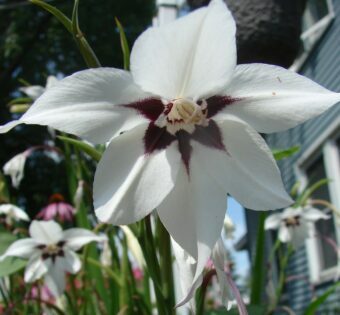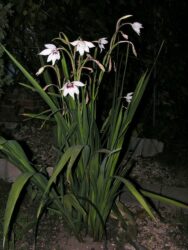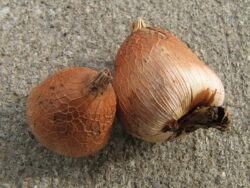In this article, we will discuss how to grow Acidanthera murielae in containers. You may know them as Acidanthera but they have been moved to Gladiolus murielae and have the common name of Abyssinian gladiolus.

It is actually a member of the Iris family and like so much in that family, it is a tender bulbous perennial with long, narrow, sword-like green leaves that die back after it has finished flowering. The leaves are nothing special but the 5cm wide, star-shaped flowers with white petals and a purple blotch at the base of each petal, are. The flowers appear in September and October, where other bulbs have finished for the season. They not only look good but they are also beautifully scented. The flowers are edible and will give a sweet or savoury take to spreads. The petals can be used to give flavour to salads.
As it is a tender plant, corms will need to be lifted if planted in the ground, but even better is to plant in containers and move them indoors before the first frost hit. The plant originates from East Africa and as a result, will do well in warm, sunny locations. They do not like cold weather and so hard frosts will need to be avoided.
Find out how to grow this cormous perennial in containers in this article.
GROWING ACIDANTHERA IN CONTAINERS
First, choose a container that is within proportion to the plant in question. Personally, I think that a 20cm container in diameter will be sufficient. Whatever you choose make sure it has plenty of drainage holes. To the container add a 1cm layer of gravel to aid drainage even further.
On top of this add a good quality multipurpose compost to 5cm below the top brim. Using a bulb planter make 10cm deep holes at gaps of 20cm apart from each other. In each hole. Place a corm and then fill each hole with more compost. It is best to plant the bulb indoors, or in a conservatory or greenhouse in April and bring them out in late May, once frosts have passed. In this way, it will give the corms a head start. Place the container in a sunny south-facing site that is sheltered from strong winds.

It may not flower in the first years but after several years it will reach a level of maturity and the result would be these beautiful flowers.
Keep watering in dry conditions, so that the compost is moist but never soggy. Soggy soil can result in the corms rotting and this is why well-draining compost is a must. Once established it tolerates drought pretty well.
In spring, as the new growth is coming through give the plant a handful of blood, fish or blood to get it through the growing season. Another handful may be given when the flower stalks start to appear.
TWO OPTIONS ARE AVAILABLE
Once it has finished flowering, you have two options:
Option 1: you can cut the old leaves and lift the corms before the first frosts hit. These can be allowed to dry off and stored in a warm but dry place. Next spring the planting process can take part once again. This is advised if you are growing directly in the ground but for pots, you can use Option 2 and move the pot under the shelter of a greenhouse to overwinter.
You will need to cut the old foliage and allow the compost to totally dry out, the containers can then be moved into a frost-free location, like a greenhouse, conservatory or even a garage. To help to give your plant additional protection you may cover the whole pot with thick horticultural fleece. In spring, you can unwrap the pots and start to water and feed as suggested above until it starts growing. In late May, you can bring the pots out in a sunny but protected location.
PESTS AND DISEASES
The young leaves can be tempting for slugs and snails to munch on. This can be avoided if you use slug pellets or woolly deterrent matting to protect your plants. Thrips can suck in the juices that the leaves produce. This can be dealt with by trying to blast them off the plant with jets of water or by using a suitable systemic insecticide.

In high humidity and damp conditions, grey mould can be a problem. To avoid this make sure that it does not get too wet or it is not grown in high humidity. Grey mould is hard to treat once it is established on the plants.
If the corms get too wet they can suffer from corm rot, which cannot be treated and the corms will need to be disposed of. Best to avoid it by growing in free-draining compost.
VARIETIES TO GROW
The only variety that you are like to find is Acidanthera murielae (Gladiolus murielae). The plant has been discussed in great detail in the introduction and so will not be repeated here.
CONCLUSIONS
In this article, we have discussed how to grow Acidanthera (Gladiolus murielae) in containers. Not only does the plant look good with its elegant flowers but it smells divine as well. They are easy to look after as long as you protect the corms each winter from severe frosts. They tend to suffer little from pests and diseases as long as you prevent the corms from getting too wet in winter.
A plant that is easy to grow and easy to look after.
If you have any questions or comments that you wish to make on growing Acidanthera (Gladiolus murielae) in containers, please do so in the comment box below.
Happy Acidanthera growing.
